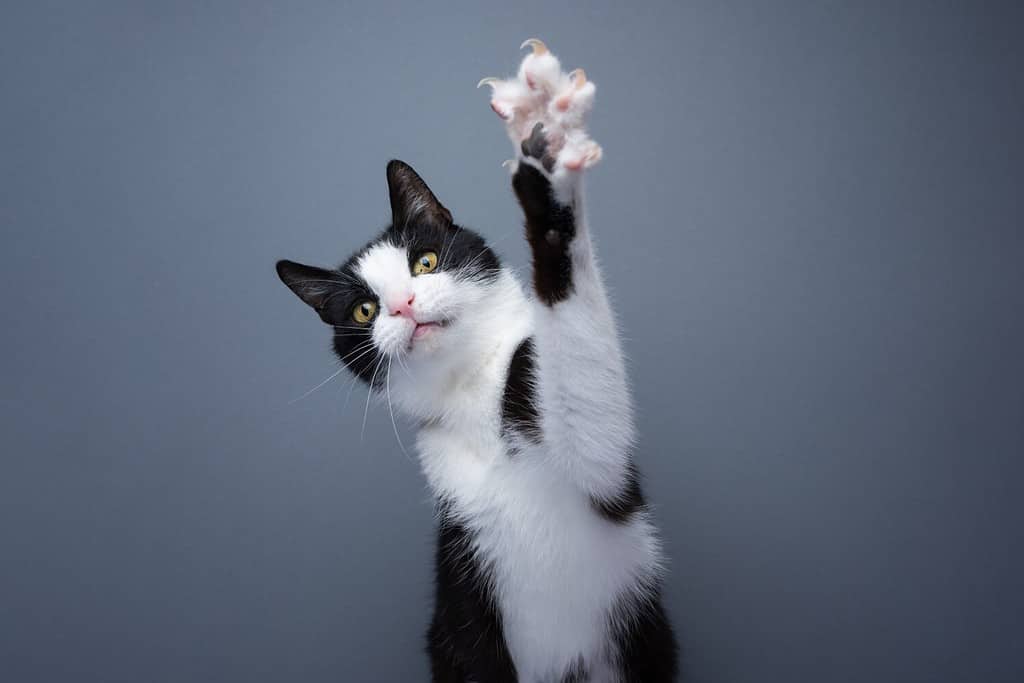
Claws are a cat’s way of communicating their emotions and claiming that an object belongs to them.
©Nils Jacobi/Shutterstock.com
Cats are the second most popular pet to own in America behind dogs but ahead of aquatic animals. They are sources of comfort when their person is low, keep them on schedule to feed and scoop their litter boxes, and keep humans on their toes with surprise attacks to relieve their hunting instincts. Cats are precious pets who have a history of being worshiped, and any cat owner knows that the cats are the dominant ones in the relationship.
However, as wonderful as cats are, all cat owners face the ongoing battle of preventing them from clawing furniture. No matter what type of breed of cat someone has, every cat has a desire to scratch and claw whatever they can get their paws on.
But why do cats scratch furniture so much? What drives them to scratch sofas, chairs, rugs, and bed frames? Sadly, this is not a fight humans can win since there are years of predator instincts being expressed in their paws. Let us explain why cats need to scratch, what cat parents can do to channel their needs, and healthy prevention methods to save the furniture.
Why Do Cats Scratch
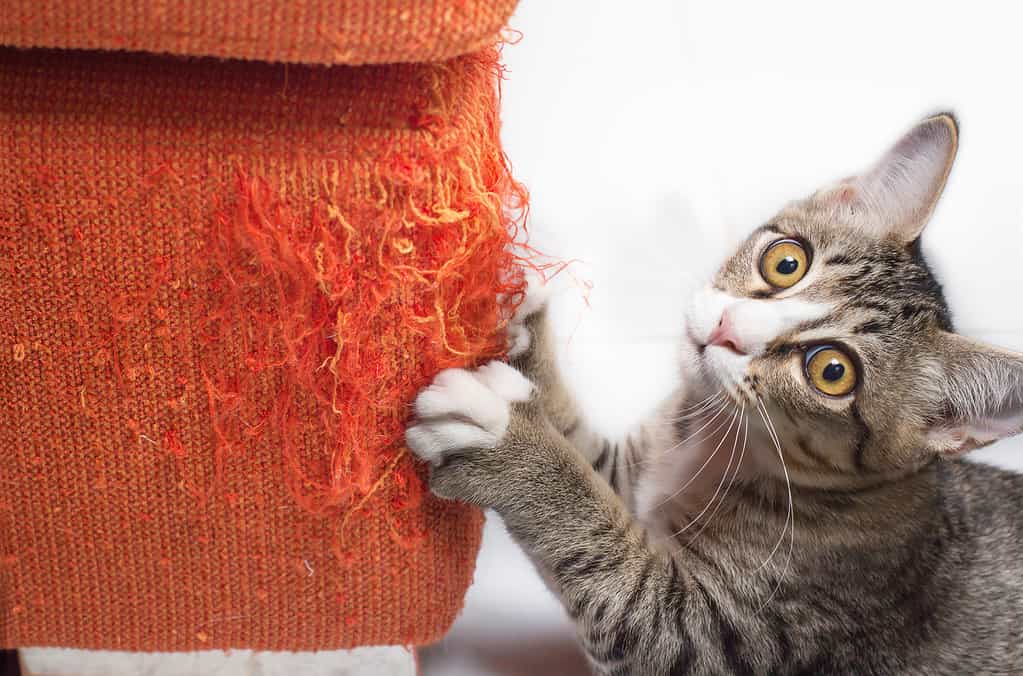
Kittens learn to scratch from their mothers and while playing with their siblings.
©noreefly/iStock via Getty Images
Cats scratch because they have an instinctual desire to scratch. Scratching is a normal behavior with all felines as a way of communicating and expressing emotion.
Domestic cats are not the only cats with a need to scratch either. Wild and big cats like leopards, lions, tigers, and ocelots need to scratch as well. They roam around their territory, scratching large trees or down tree trunks daily. Visit a zoo and look around the big cat enclosures and you will notice the trees will have claw marks or scratches on the bark.
Cats were never completely domesticated the same way dogs were. Dogs became obedient servants to humans to create a mutually beneficial relationship. On the other hand, cats hunted mice, birds, and reptiles that plagued farms on their own. Humans offered cats shelter in the summer or winter, and in turn, the cats ate the rats within the house. Their instincts to hunt and scratch remained since they needed their claws sharp and ready to catch prey.
Reasons Why Cats Scratch
Aside from the instinctual need to scratch, cats use scratching as a means to convey emotion or communication. Depending on where they live and what they are doing, it can mean multiple things.
Exercise
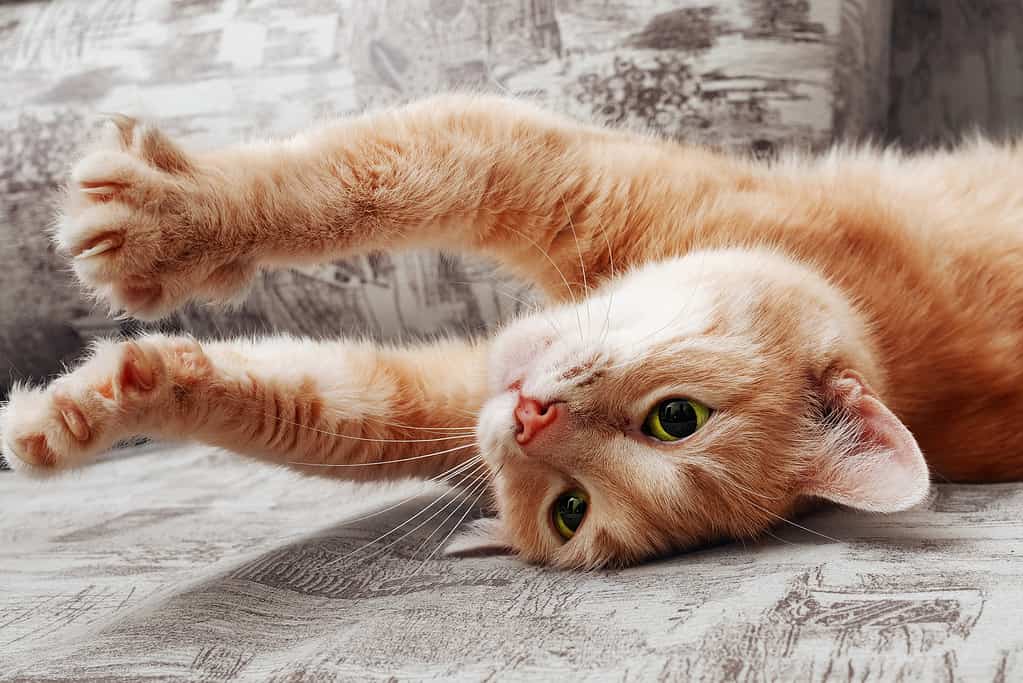
Scratching posts are a good way for cats to get their blood pumping after a short nap.
©asadykov/iStock via Getty Images
Scratching is an excellent way to stretch and exercise their bodies. When cats scratch a big tree or tall scratching post, they stretch their bodies at the same time. This loosens the muscles in their toes, legs, backs, thighs, and arms. The taller the scratching post, the longer and higher the cat can stretch. Similar to how humans stretch after a nap, cats stretch using scratching posts to get blood pumping through their bodies after their many naps.
Mark Territory
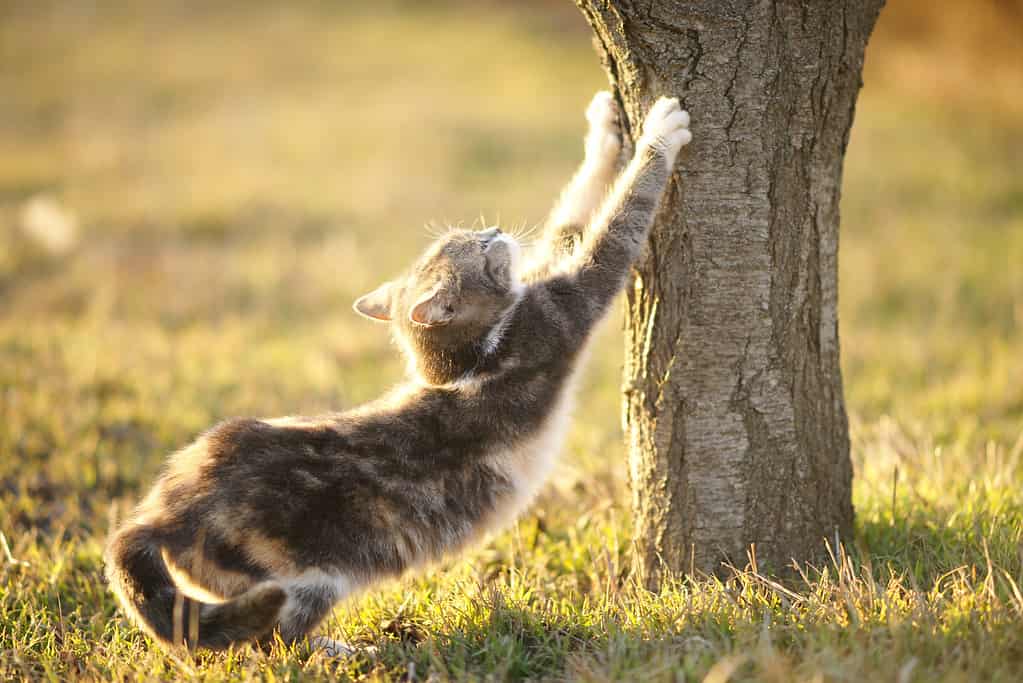
Outdoor cats mark their territory by scratching tree trunks and downed logs to inform other cats to stay away.
©sony_moon/iStock via Getty Images
Cats use scratching as a method of marking their territory to other cats and predators. In the wild, cats will scratch trees, logs, and any other surface to inform other cats or predators that they are in occupied territory as a warning not to come closer.
Additionally, cats have scent glands on their paws to help them mark their territory. If the scratching does not deter rival cats, the scent is an additional way for cats to communicate who is around. Domestic cats will scratch objects like chairs or furniture to put their scent on them and warn other animals of their territory. In the same way dogs roll on furniture to get their scent on it, cats use their paws to place their scent on it. Unfortunately, it comes at the cost of damaging the furniture from sharp nails.
Stress Relief
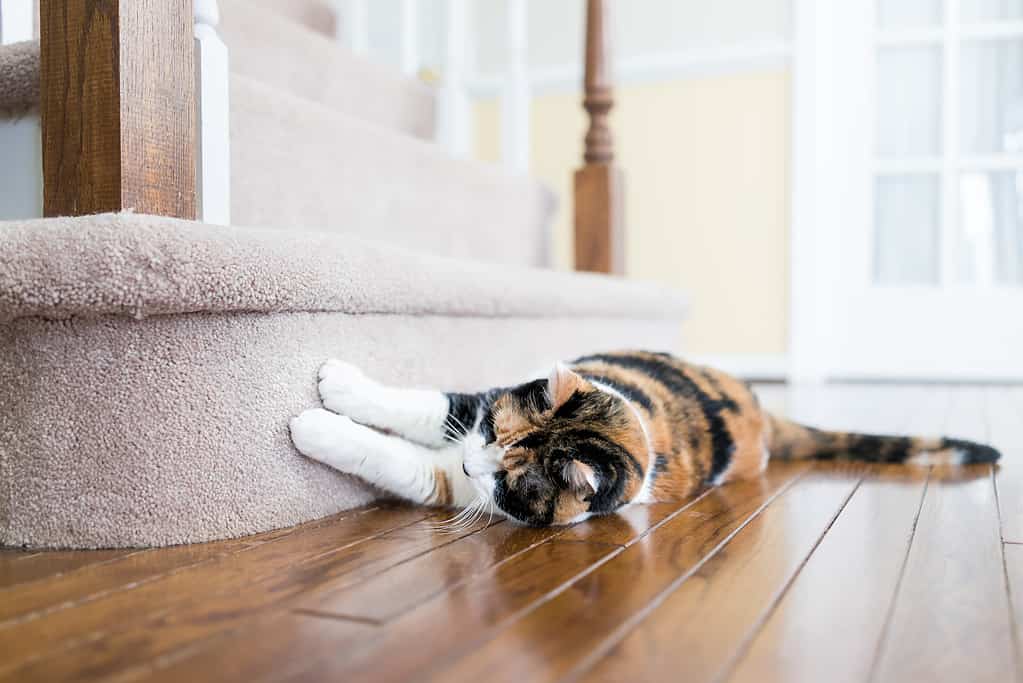
Certain textures feel good and soothe felines while they are scratching it.
©krblokhin/iStock via Getty Images
Cats find comfort in doing something within their control when stressed. Some cats may chew on an object, others may hide in certain areas, and others will have a specific object they like to scratch.
Vengeful Scratching

Cats are very expressive creatures and will actively find ways to get their owner’s attention by doing things they know they should not be doing, like scratching new sofas.
©Veronika Viskova/iStock via Getty Images
Alternatively, an upset cat will actively scratch something they know they are not supposed to as a means of spiting the owner. Cats are social animals and need to have a certain level of attention and praise from their owners. Every cat owner is aware that when a cat is not getting enough attention, they will sit on laptops, keyboards, important papers, or knock stuff over to get attention. Destructive scratching is another ploy cats use to obtain that attention.
Sharpening Nails

Kitten nails are extremely sharp and need to be trimmed often as they are continuously growing.
©brunorbs/iStock via Getty Images
The main reason why cats scratch is to remove old and dead parts of the nails. Dog nails engage the ground every time they walk, keeping them short when they have an active exercise regimen. Cat nails are sheathed and only come out when they want them to. Scratching helps keep nails sharp and manageable, so they are ready to hunt and capture prey.
Cat’s nails split every two to three months, making way for the new nails to grow. Nails that are not maintained will be thick with several layers covering them. Some cats may chew their nails to help split their nails.
Cats are constantly grooming themselves. They will always keep their fur clean and nails short, so they are ready for anything.
What Do Kitties Like to Scratch
Cats are picky creatures and have their preferences on what feels good to them. Some cats may enjoy certain fabrics more than others where the cat owners have to perform trial and error to see what they like.
Typically, cats enjoy textures that mimic trees, bark, or something tough and strong to help them really dig their nails.

Sisal rope is a strong and durable material kittens enjoy scratching before they can dig their nails in and feel the resistance to trim their nails.
©Svetlana Sultanaeva/iStock via Getty Images
Common textures cats like to scratch are:
- Sisal rope
- Carpet
- Corrugated cardboard
- Natural wood
Also, different positions and angles of scratching posts provide more engagement for a cat to scratch.
For example, horizontal scratching posts are good for older cats with weaker joints to help them stretch and trim their nails when they struggle with standing up on tall posts. Horizontal posts provide more height for cats to reach up and stretch more muscles. Slanted posts allow cats to dig their nails in while placing weight across their paws to reduce strain on the back legs.
Supporting a Cat Scratching at Home
Look, there is no way to prevent a cat from scratching. It is an instinctual need that is in their genes, dating back farther than recorded history. Cats need to scratch, and it is the responsibility of a caring cat owner to support their cat’s scratching, while also protecting their furniture.
Tips for helping a cat scratch and protect furniture are:
- Place several scratching posts around the house. Offering multiple scratching posts gives a cat more options to scratch, preventing them from wanting to scratch furniture.
- Sprinkle catnip on new scratching posts to encourage cats to interact and scratch the new surface. Cats can be nervous about new things in the house, and catnip is a natural herb that makes cats feel happy and euphoric. They will associate the new scratching post or mat with good feelings and use it over furniture.
- Introduce nail clipping to kittens when they are young to help manage nail care. Cats are social groomers and will lick other cats to help them stay clean. By introducing nail clipping early on, cat owners can directly help keep their cat’s nails short to prevent damage to their surroundings.
- Make sure all scratching posts are firmly planted on the ground or heavy enough to withstand the cat’s weight when leaned on. If the posts are not stable, it will make the cat nervous about using them and seek out other options where they can lean against the object without worry.
Should You Declaw a Cat to Stop Scratching
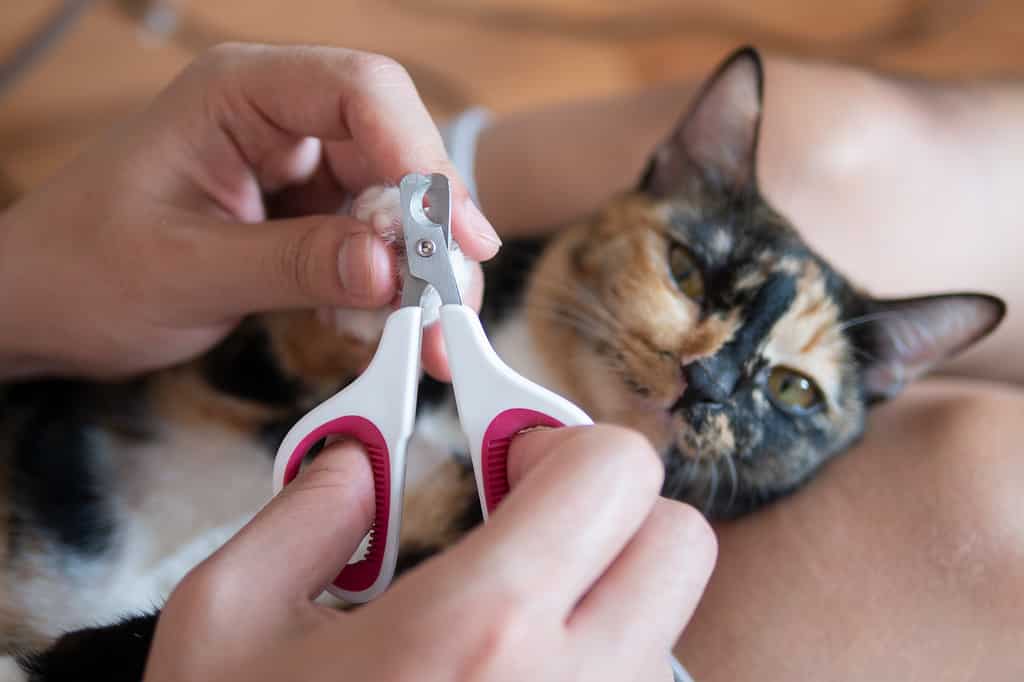
Trimming a cat’s nails is a healthier and natural way of keeping nails trimmed while protecting furniture. Introduce nail clipping early to help prevent scratching on unwanted surfaces.
©LukyToky/iStock via Getty Images
No. Never declaw a cat. Declawing a cat is an inhumane method of protecting furniture because it actively harms the cat.
Declawing is a surgical procedure where sections of a cat’s toes are cut off, preventing nails from growing back. To achieve this, several bones in the toes are removed, altering how a cat walks and balances on its feet. Without those bones, cats will feel chronic irritation and pain in their legs and backs.
Declawed cats are unable to scratch but will still have the desire and try to scratch by rubbing their paws on posts or available objects.
As of 2023 declawing is illegal in the following states:
- New York
- Maryland
- Rhode Island
- Oregon (special conditions)
- California (eight cities banned)
More states are considering banning declawing as it is seen as an inhumane practice when other methods are available like cat nail caps, which can be placed on the nails to engage scratching without damaging surroundings, or several of the options stated earlier.
Cats are amazing animals that need to scratch. It is in their biology to scratch that predates the human-cat relationship. Big cats like lions and tigers have that same desire to scratch and claw surfaces because they need to. Cat owners know that we serve our cats. So, we have to do everything we can to give them what they want, hoping our offerings will grace their patience and spare our furniture.
The photo featured at the top of this post is © iStock.com/Magui-rfajardo
Thank you for reading! Have some feedback for us? Contact the AZ Animals editorial team.







